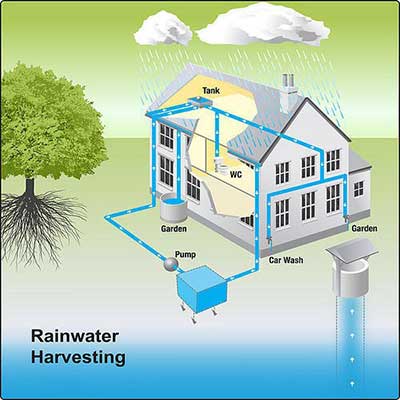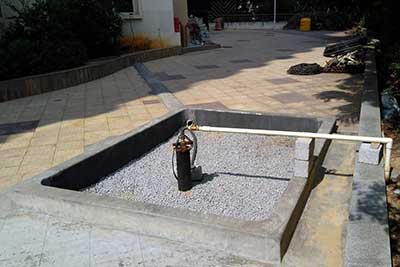Date: 29/10/2022
Relevance: GS-3: Water resources, conservation, environmental pollution and degradation, disaster and disaster management.
Key Phrases: Rainwater harvesting, World Water Development Report 2015, Sustainable water management, Rainwater harvesting techniques, Traditional methods of water conservation, Apatani, Zing-tanks, Khadin, Water Security
Context:
- The NITI Aayog report (2018) says that India’s water demand will exceed water supply by a factor of two by 2030.
- The major source of water supply is groundwater for most regions in India and rapidly depleting groundwater levels call for urgent attention for ensuring water security in the coming years.
Do You Know?
- India covers around 2.45% of the world's surface area and has 4% of the world's water resources.
- In India, rainfall is the primary source of freshwater.
- For a country of its size, India receives the second most amount of rainfall.
- India receives an average of 1,170 millimeters (46 in) of rain per year, which equates to around 4,000 cubic kilometers (960 cu miles) of rain per year, or about 1,720 cubic meters (61,000 cu feet) of freshwater per person.

Declining groundwater is a concern
- According to the World Water Development Report 2015 (UNESCO), India is a frontrunner in groundwater extraction.
- The water table is going down in several areas and there are many
reasons for this decline
- Overexploitation of shared water resources.
- Mismanagement of water resources.
- Climate change impact.
- Several metropolitan cities are already facing difficulties meeting
water demand due to high population density and limited water resources.
- For example, Delhi has a water supply of approximately 930 million gallons a day (mgd) while its demand is 1,380 mgd.
- The Delhi Jal Board (DJB) plans to meet this growing demand through groundwater sources which will lead to over-exploitation of groundwater sources.
Government efforts to reduce groundwater depletion
- For improving access to water, the government has given special
focus to implementing “source sustainability measures” such as
- Recharge and reuse through grey water management.
- Water conservation.
- Rainwater harvesting (RWH)
- A campaign to “Catch the rain, where it falls, when it falls”, has been launched which aims to create appropriate rainwater harvesting structures.
- Several government schemes such as Atal Bhujal Scheme are
focusing on aquifer mapping to construct artificial reservoirs and
rainwater harvesting structures.
- These mapping techniques take into account hydrogeology and source water availability.
Rainwater Harvesting
- The rainwater harvesting process incorporates collection and storage of collected rainwater with the help of artificially designed systems.
- Rainwater harvesting systems consists of the following components
- Catchment- Used to collect and store the captured rainwater.
- Conveyance system – It is used to transport the harvested water from the catchment to the recharge zone.
- Flush- It is used to flush out the first spell of rain.
- Filter – Used for filtering the collected rainwater and removing pollutants.
- Tanks and the recharge structures: Used to store the filtered water which is ready to use.

Some traditional water harvesting techniques
- Kuls: Often spanning long distances, with some over 10 km long, kuls have been around for centuries. They are present in mountain areas Jammu, Himachal Pradesh.
- Tanka system: it is used in Rajasthan, which is a cylindrical ground pit that receives rainwater from the nearby catchment area.
- Virdas-Virdas are shallow wells dug in low depressions called jheels (tanks) , they are found in Runn of Kutch area in Gujarat.
- Madaka-It is a unique structure constructed on the upper reaches of undulating topography
- Khadin- a very long (100-300 m) earthen embankment built across the lower hill slopes lying below gravelly uplands.
- Bamboo drip irrigation: used in the northeast, suitable for irrigation in hilly terrains.
- Tanks in Karnataka: these are artificial reservoirs to store water taking advantage of depression.
- Zing -Tanks: for collecting water from melted ice in Ladakh.
- Stepwell: these are found in Rajasthan and Gujarat.
- Baoris / bers – they are community wells in Rajasthan.
- Apatani –Terraced plots connected by inlet and outlet channels in Arunachal Pradesh.
- Pyne-ahar: system of south Bihar on which the cultivation of paddy depends.
The many benefits of artificial recharge
- Artificial recharge structures augment the water supply and thus improves the groundwater resource availability.
- No land is wasted for storage purposes and no population displacement like dams etc.
- Sub surface water harvesting is cost effective than Surface water storage (dams)
- Ground water is not directly exposed to evaporation and pollution.
- It increases the productivity of aquifers which may serve as a distribution system also.
- Storing water underground is environmentally friendly, reduces flood hazards.
- It affects the rise in groundwater levels and helps in mitigating droughts, soil erosion etc.
Significance of rain water harvesting
- Ensuring Food Security:
- Modern hybrid crops & fertilizer depend on continuous supply of irrigation water.
- More than 60% of net sown area in India is rainfed and to address the rising cases of drought in the dry belt of India and ensure food security RWH is essential.
- More than 3/4th of the precipitation In India occurs during 4 months of monsoon season and significant part of which is lost in runoff and evaporation, this can be controlled by rain water harvesting.
- Rapid urbanization and Industrial development demands huge water hence severe water crunch can be addressed by water harvesting.
- In dry and hilly areas women face hardship in fetching water and in such remote areas RWH can provide a decentralized source of water which would reduce their hardships.
Way ahead
- There is a need to enhance efforts to reduce dependency on
groundwater with a focus on
- Enhancing water security.
- Rejuvenation and recharge of natural and constructed water bodies.
- Increased reuse of treated wastewater through local sewage treatment plants.
- Build well-designed rainwater harvesting systems across residential and commercial areas.
- These efforts must be facilitated by cooperation of Central and State governments.
- There is a need for stringent policy initiatives for long-term and sustainable solutions.
- An integrated water management plan must be brought up by local bodies and implemented at the local level.
Conclusion:
- Rain water harvesting not only provides the most sustainable and efficient way of water management but also opens the vista of several other economic activities leading to Empowerment of people at grass root.
- Therefore the need of the hour is to promote rainwater harvesting using a mix of traditional ecologically safe, viable and cost-effective systems with modern rainwater saving techniques, such as percolation tanks, injection wells and subsurface barriers to rejuvenate India’s depleted water resources. But using only traditional methods is not enough. Productively combining these structures could be the answer to India’s perennial water woes.
Source: The Hindu BL
Mains Question:
Q. “Water resources are critical for life, and are also essential for economic development.” in light of the statement critically examine the need of rainwater harvesting and artificial recharge in India. Also write on three traditional and modern rainwater harvesting techniques. (250 words).






















